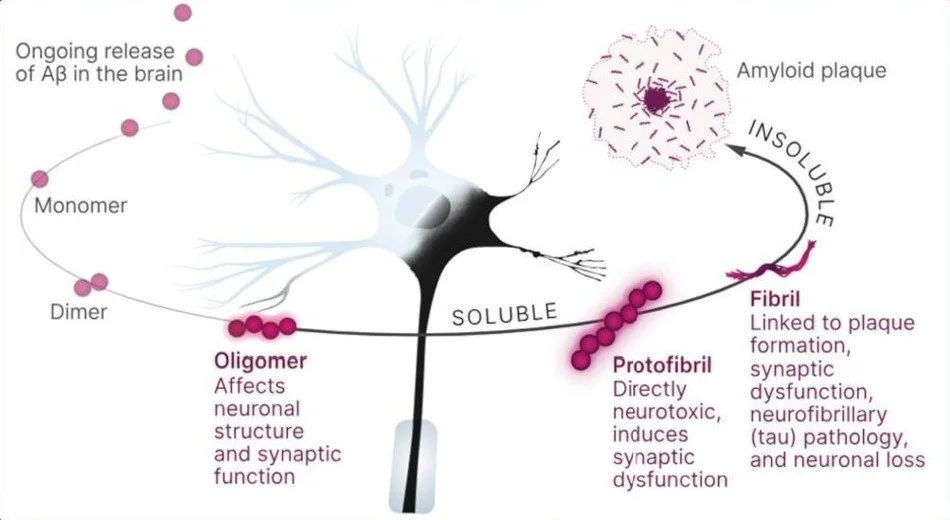How Leqembi’s Multi-Target Strategy Fights Alzheimer’s
Alzheimer’s begins with tiny toxic proteins that build into destructive plaques. Leqembi is different — it attaches at multiple points in this process, giving the brain a better chance to defend its neurons, preserve memory, and protect identity.
If you want the simple answer, watch this video Only LEQEMBI works on fighting Alzheimer's disease in 2 ways
https://www.leqembi.com/en/how-does-leqembi-work
If you are interested in the science behind this drug, read more.
One of the amazing things about Leqembi is the way it attaches not only to plaques, but also to beta-amyloid as it is forming into plaques. To understand how a drug works, it helps to understand the physical changes that cause the problem. In Alzheimer’s, plaques and tangles damage and kill neurons, disrupting the very networks that make thought and memory possible.
Your brain has over 100 billion neurons and 100 trillion connections—more than the stars in the Milky Way! These neurons are the messengers of thought and memory, linking together into vast networks that give rise to everything you know and experience.
In the beginning, this network is an overabundance of possibilities, a plethora of circuits waiting to be refined. Then experience begins to sculpt it. Every sensation, every movement, every thought leaves its trace: some pathways strengthen into reliable highways of communication, while others gradually fade like unused side roads. With each moment of living, the brain edits and rewires itself, shaping a network that is both structured enough to hold memory and identity, yet flexible enough to learn, adapt, and change.
The result is not just a network of neurons, but a living, self-designing system more intricate than any machine. Out of the constant interplay of axons, dendrites, and synapses arises something astonishing—the ability to think, to feel, to imagine, and to be aware.
This is the system Alzheimer’s threatens to unravel. By targeting beta-amyloid before and after it forms plaques, Leqembi helps protect these extraordinary networks, giving the brain a chance to preserve the very connections that make us who we are.
How neurons work:
· Dendrites receive signals from other neurons
· Cell body (soma) processes and decides its function
· Axon carries the message forward
· Myelin sheath keeps signals fast and efficient
· Synapse or axon terminals passes the signal to the next neurons
This seamless system lets us think, remember, and respond in an instant.
What goes wrong in Alzheimer’s:
· Plaques (beta-amyloid): Misfolded proteins become sticky and clump outside neurons. They build up around axons and damage the myelin sheath (the insulation on the neuron’s “wires”). Without myelin, signals slow down or get blocked, disrupting communication.
· Tangles (tau): These form inside neurons. Tau proteins, which normally keep the neuron’s transport system running, twist into clumps. This strangles the soma (cell body), so it can no longer process signals or direct the neuron’s activity.
Together, plaques and tangles break down communication, starve neurons, and eventually cause them to die—leading to memory loss and decline in thinking.
Beta-amyloid begins as a single misfolded protein unit called a monomer. These monomers are unstable and sticky. When two bind together, they form a dimer, and as more join in, they create larger clusters called oligomers. Oligomers can assemble into protofibrils, which eventually organize into long fibrils that accumulate into the plaques seen in Alzheimer’s disease.
Oligomers – the most toxic form; they attack synapses and disrupt cell membranes.
Protofibrils – worsen damage by amplifying oxidative stress and harming
Leqembi is a treatment made of special antibodies. It attaches to oligomers, protofibrils, and amyloid plaques and flags them for the immune system. Immune cells then break them apart, and the brain’s glymphatic system flushes them out.
In short: Neurons are our brain’s messengers. Plaques and tangles disrupt and destroy them. Leqembi helps the brain clear of oligomers, protofibrils, fibrils and plaques, giving neurons a better chance to keep working.


